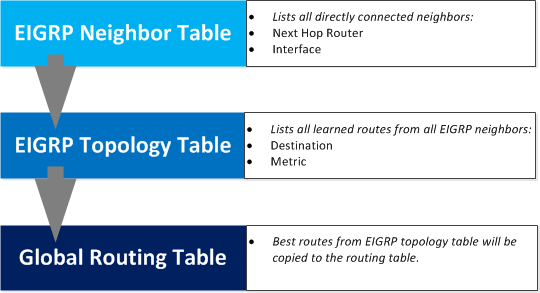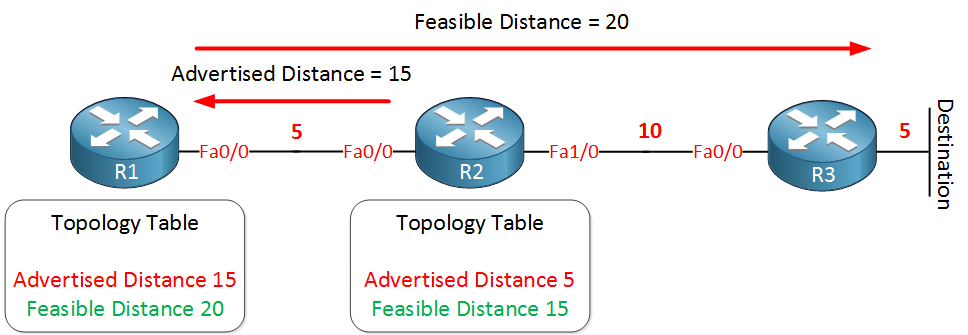In this lesson, we’ll take a look at EIGRP (Enhanced Interior Gateway Routing Protocol), which is Cisco’s routing protocol. If you are unfamiliar with distance vector and RIP, I highly recommend reading my Introduction to RIP first before continuing.
EIGRP stands for Enhanced Interior Gateway Routing Protocol and is a routing protocol created by Cisco. Originally, it was only available on Cisco hardware but for a few years, it’s now an open standard. EIGRP is called a hybrid or advanced distance vector protocol, and most of the rules that apply to RIP also apply here:
- Split Horizon
- Route Poisoning
- Poison Reverse
EIGRP routers will start sending hello packets to other routers just like OSPF does, if you send hello packets and you receive them you will become neighbors. EIGRP neighbors will exchange routing information which will be saved in the topology table. The best path from the topology table will be copied into the routing table:

Selecting the best path with EIGRP works a bit differently than other routing protocols, so let’s see it in action:

We have three routers named R1, R2, and R3. We are going to calculate the best path to the destination, which is behind R3.
EIGRP uses a rich set of metrics, namely bandwidth, delay, load, and reliability, which we will cover later. These values will be put into a formula, and each link will be assigned a metric. The lower these metrics, the better.
In the picture above I have assigned some values on the interfaces, if you would look at a real EIGRP router you’ll see the numbers are very high and a bit annoying to work with. R3 will advertise to R2 its metric towards the destination:

Basically, R3 is saying to R2: “It costs me 5 to get there”. This is called the advertised distance. R2 has a topology table, and in this topology table it will save this metric, the advertised distance to reach this destination is 5.
We are not done yet since there is something else that R2 will save in its topology table. We know the advertised distance is five since this is what R3 told us. We also know the metric of the link between R2 and R3 since this is directly connected. R2 now knows the metric for the total path to the destination, this total path is called the feasible distance, and it will be saved in the topology table:

You have now learned two important concepts of EIGRP. The advertised distance, your neighbor tells you how far it is for him to reach the destination, and the feasible distance which is your total distance to get to the destination.
Let’s continue! R2 is sending its feasible distance towards R1, which is 15. R1 will save this information in the topology table as the advertised distance. R2 is “telling” R1 the distance is 15:
